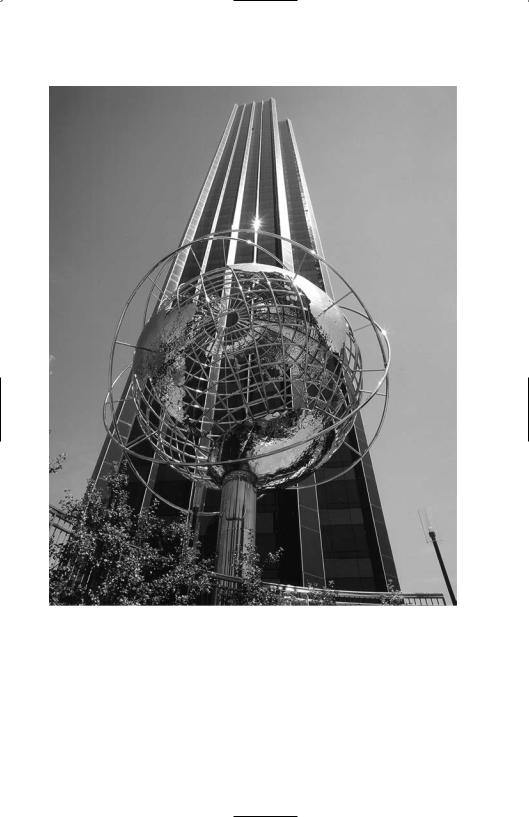
Trump_Never_Give_Up
.pdf
T R U M P : N E V E R G I V E U P
the New York Post. W hat a lot of people don’t k now is that it was formerly the Gulf & Western/Paramount building. It was owned by General Electric, which had Jack Welch, John Myers, and Dale Frey at the helm; and it was an office building. It really stands out because it’s one of the few tall towers on the West Side. It went up in the early 1960s, just before zoning laws were passed that would prohibit such a tall building at that location.
This building managed to attract a lot of attention, not
just because of its height, but because of some construction problems that had the tenants on edge. For one thing, it swayed in the wind and would f lex at the top with winds of only 15 miles per hour. All buildings have some f lex ibility but this
was an exceptional situation. Elevators would stop, and some tenants even said they felt seasick. Once, when there was a high wind, the upper windows fell out. These episodes were legendary.
Let’s just say this building had some problems, some pretty major problems. Also, it was not constructed very well because the outside curtain was made of glass and cheap aluminum, and it was chock full of asbestos. The good news was that the building structure was classic and had wonderfully high ceilings. It was worth saving for those important reasons alone.
W hen I heard this building was for sale, I called Dale Frey and asked to meet him. That’s when I found out he was receiving calls from many major developers around the country. I would have a lot of competition. However, I arranged for a meeting, and I explained that if the building was completely demolished, it could only be rebuilt as a 19-story building versus the 52 fabulous stories that it was. That alone was a big reason to see what could be salvaged, but it would require a lot of research, which I immediately started doing.
W hat I suggested was that the steel structure could be strengthened, and the high ceilings would be ideal for a residential building, which was also a hotter item in the market than a business space would be. This was the perfect location for a lux-
50

S O M E T I M E S Y O U H A V E T O S W A L L O W Y O U R P R I D E
ury residential building. General Electric seemed impressed with my ideas, and I felt good about their positive reaction to everything I had presented. My only concern at this point was that I was just emerging from some financial problems, so they might be hesitant to take a chance on me.
W hat happened next came as a shock. Dale Frey called to tell me that while he liked my plans a lot, they were putting the job out to bid. They would ask some of the biggest real estate firms in the country to put in a bid, and he hoped I’d be among them. I was astonished by this because I had spent a lot of time on my concept, and had explained it to them personally. Now I had to start over and bid like a newcomer to the project.
I felt miserable and a bit outraged by this turn of events. I’d basically be entering a public contest, which I didn’t think was necessary. I was wondering if they had just been humoring me all that time, even though they appeared to be interested and impressed with my ideas. W hat could I do? I was definitely interested, I’d already spent a lot of time and effort on this, so I finally swallowed my pride and decided to just go for it. I like challenges and this had become an even bigger one, not that I was happy about it. So I worked on a fantastic and detailed presentation. W hen I say put everything into what you’re doing, this was a good example.
It seemed like ages, but General Electric finally called to say they were going with me. Being chosen by this power group to develop this incredible site was wonderful news. Trump International Hotel & Tower would become a reality. It made all the aggravation of the process worth it. Dale Frey and John Myers at GE made it possible—they are great guys.
In 1995, we began to demolish the former Gulf & Western tower—only the steel structure would remain. I had Philip Johnson lined up as the architect along with Costas Kondylis & Associates, so we were assured of a spectacular as well as elegant building. Philip Johnson had designed the State Theater at Lincoln Center, which is only a few blocks away. This was an
51

T R U M P : N E V E R G I V E U P
Trump International Globe
important building and I wanted the very best. That’s exactly what all of us got.
Trump International Hotel & Tower is now the #1 hotel in New York City. It includes Jean Georges Restaurant, which is ack nowledged as one of the great restaurants of the world. The
52

S O M E T I M E S Y O U H A V E T O S W A L L O W Y O U R P R I D E
condominiums in the building stay on the market for a very short time. There are waiting lists for everything concerned with this building. It’s also the first time a hotel and condominium have been combined, which people now hail as an innovation. It wasn’t an innovation to me, just common sense. In fact, it’s an idea that is copied around the world today and with great success. So take the time to think things through.
Yes, the original building had major problems; yes, the approval process was confounding, but that was part of the challenge. It also provided me with a great opportunity. Sometimes you have to look a little harder to see those opportunities, but believe me, it’s worth it.
53

12
C O U R A G E I S N ’ T T H E
A B S E N C E O F F E A R ,
I T ’ S T H E C O N Q U E R I N G
O F F E A R
Courage means never giving up. It’s much easier to give up, and that’s exactly what losers do. Being k nocked down is
one thing—staying down is another. Some very ordinary people have accomplished remarkable things by simply being persistent and never giving up. Abraham Lincoln is a good example—his courage made him extraordinary.
On The Apprentice, the candidates must first go through a grueling audition process. There have been millions of applicants, and only a few people are chosen. Those aren’t terrific odds. That’s why I firmly believe that there are no losers on that show. The people who try out for the program show great
54

C O U R A G E I S N ’ T T H E A B S E N C E O F F E A R
courage to begin with. They are all winners. Being fired in front of millions of people isn’t easy, but that’s part of the deal and they persist anyway. Most of them say the experience was worth everything they put into it, whether they won or not.
Hemingway wrote the now familiar phrase, “Courage is grace under pressure.” Think about it. Some days we are faced with challenges that we’d rather not have to deal with, but we get up and deal with them anyway. That’s courage. It requires a certain poise. Maybe it’s not heroic, maybe every day isn’t going to bring a calamitous situation, but it’s an example of bravery that we can all understand.
Self-confidence is a component of courage that we all need. Sometimes we need a push in the right direction. I worked with a young executive who had never done any public speaking, so he decided he wasn’t any good at it. He told me so, and I thought to myself, “He hasn’t even tried public speaking, and he tells me he’s no good at it!” I had a feeling he’d be good at it. A few months later when I realized I wouldn’t be able to make a dinner engagement that included a short speech, I told him he’d have to step in for me. He told me, “I don’t do public speaking.” I said to him, “ You do now.” End of conversation. Do you k now what? He’s become an accomplished speaker. Courage isn’t the absence of fear, it’s the conquering of fear.
The phenomenon of stage fright is a good example. I read an article recently about how common stage fright is, even among professional actors. There are a lot of very accomplished and famous performers who deal with it regularly, sometimes for decades. They don’t let their fear get in the way of their passion. I’m used to speaking in front of tens of thousands of people, and I find it enjoyable, but I’ve often had people ask me if I get nervous. I don’t. I just go out and do it.
Winston Churchill was a great orator, but I read that he spent a lot of time developing this skill. He wasn’t a natural in the beginning, but he worked at it until he mastered it. He
55

T R U M P : N E V E R G I V E U P
became a powerful and mesmerizing speaker. One of his most famous speeches during World War II included these words:
Never, never, never, never, never, in nothing great or small, large or petty, never give in, except to convictions of honour and good sense. Never yield to force; never yield to the apparently overwhelming might of the enemy.
Churchill and his people were in danger of being bombed out and overrun by the German military when he said that. You might not be experiencing the blitz, but you can still apply those words of courage to your daily life. There are days when I have so many problems come at me at once that it can seem like the blitz. I don’t give in to them, and neither should you—ever!
Another important thing about courage is that it will help you think and act in the right way. It will help you focus on the opportunities in front of you instead of on the problems. Problems are often opportunities coming at us in packaging that isn’t what we expect or want. This has happened to me more times than I can count. So when I say I welcome problems, there’s a reason for it. Keep your mind f lex ible and open to creative solutions to your problems. Einstein said, “ You can’t solve a problem with the same thinking that created the problem.” That’s a good way to avoid brain cramps as well as find a solution.
Back to courage. Remember that fear can be conquered. Know that you are capable of courage and that you are designed to succeed—that’s half the battle. Then go full throttle, and the odds will be on your side.
56

13
B E P A S S I O N A T E — I T ’ S
T H E O N L Y W A Y T O
M O V E M O U N T A I N S
B u i l d i n g T r u m p
I n t e r n a t i o n a l G o l f C l u b
When I decided to build my first golf course, I found a good piece of land near my Mar-a-Lago estate in Palm
Beach and decided to go all out. I hired Jim Fazio, one of the all-time great golf course designers. W hen he told me he’d have to move over three million cubic yards of dirt to make the relatively f lat land into a spectacular course, I didn’t blink an eye. I was excited about building my first golf course and ready to move mountains if necessary.
I did, however, wonder what I’d gotten myself into once again. Shortly after hearing the three million number, he told
57

T R U M P : N E V E R G I V E U P
Palm Beach
me it would be necessary to bring in over five thousand trees, and about a thousand royal palms, and over a thousand coconut trees. Then there would need to be about $2 million worth of little plants to make everything look well groomed. The water feature for one hole, number 17, would cost close to $3 million dollars and take about nine months to complete. This was going to be an 18-hole course. I almost started to worry.
I k new Jim was giving me straight, well-thought out numbers for his work. His integrity is legend. This is simply how much it costs to get an extraordinary piece of work done, I told myself.
T H E L O W P O I N T
I realized that my original $40 million estimate might be way too low. Is this what happens when a developer who specializes
58

B E P A S S I O N A T E
in skyscrapers turns to golf course development? Was I making a huge mistake? Should I have stuck with terrain that I k new more about already?
I’ve always told people to k now what they were doing first, to do due diligence to the nth degree, to be cautiously optimistic. I suddenly found myself wondering why I didn’t heed my own advice. I was facing a lot of new issues where I wasn’t yet an expert. However, I was excited about the fact that we were building something outstanding, and that kept me going.
Jim Fazio often says that one of the great things about working with me is that I never asked him if we were spending too much money. Instead I’d ask, “Do you need anything else?” He said that attitude helped his creative process. I’m glad he thought that because in a big way that’s how it was. I have to admit that I had a few moments of doubts. Not big doubts, but doubts nevertheless.
For example, it took a solid year to move three million cubic yards of dirt and to transplant five thousand trees. This wasn’t fast going, but it was necessary, and it was painstaking work on Jim’s part. Then, the Department of Environmental Resources told us that only 50 acres could be cleared at a time, which required us to plan the course in seven sections. This also involved labeling all the trees and building a lake system. So it took a year before the golf course could even begin to be built.
Fortunately, I’m a patient man when it comes to things I care a lot about. I was very excited to have a spectacular course, and I realized that if this is what was required to have that, then so be it. I had made my decision, and I decided to stick with it. I also k new I had a real pro working for me. Jim Fazio’s reputation preceded him, and I could see for myself that he was totally reliable as well as genuinely passionate about his work. Was I expecting the impossible?
W hen you are faced with situations like these, it’s important to think about why you are doing whatever you’re doing in
59
